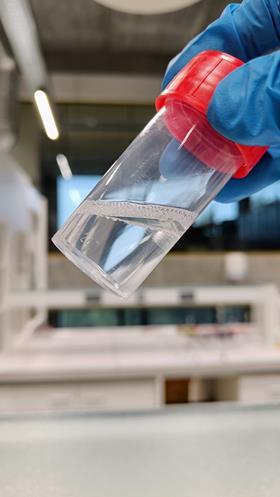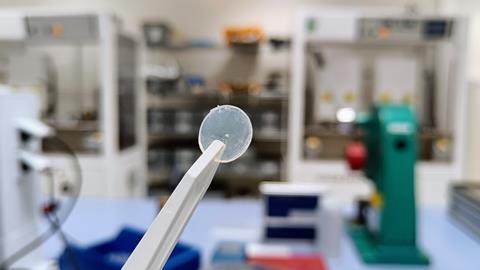A team from the University of Hasselt and the research institute imec presents in Advanced Science a new electrolyte that combines the properties of solid and liquid electrolytes in batteries. ‘We actually cheat a little.’
A battery consists of three essential components: anode, cathode and electrolyte. ‘The electrolyte provides the ions needed to close the circuit between the anode and the cathode’, explains An Hardy, full professor at the Institute for Materials Research at UHasselt. ‘In an AA battery or a car battery, the electrolyte is often a liquid. We wanted to replace this with a solid electrolyte.’ This is mainly for safety reasons, because it reduces the risk of thermal runaway in the battery. Another advantage is that you can also use lithium metal, which increases the energy density.

Matrix
‘We actually cheat a little’, says Hardy with a laugh. In fact, her group is fixing a liquid electrolyte in a matrix so that it behaves like a solid: a solid composite electrolyte (SCE). You get the best of both worlds.
Dries De Sloovere, postdoc in Hardy’s group and R&D project leader at imec, explains their battery innovation: ‘There are three important factors: functional properties, manufacturability and compatibility with electrodes. The first is: does the SCE work well? This type of electrolyte has to conduct ions very quickly and be stable at the same time.’ That is not the hardest part. It is the combination of these three factors that makes or breaks an electrolyte.

Five minutes
The production process – the manufacturability – is in part what sets Hasselt’s product apart from other SCE’s. ‘We start with a liquid, from which we make a precursor solution that we leave to react for several weeks’, De Sloovere continues. You can then simply drip this solution onto reasonably porous electrodes so that it can easily be absorbed.’ Finally, you expose the whole thing to UV light for five minutes, which solidifies the electrolyte.
‘It may seem trivial, but the advantages of our approach are very important in terms of industrial processes’, says Hardy. ‘On an industrial scale, you don’t want to be stuck with waiting times, which is the case with other SCEs. A coated electrode often has to mature for several weeks before you can work with it, whereas our liquid hardens in five minutes.’
It also helps that you can start with a liquid. The industry already has a lot of experience with liquid electrolytes and the technology is there. Hardy: ‘It’s a much less drastic change than if you were to go to a ceramic conductor process.’
‘The advantages of our approach are very important in terms of industrial processes.’
An Hardy
The third factor is the compatibility of the electrolyte with the electrodes. ‘Many liquid electrolytes contain reagents that help convert everything from liquid to solid’, says De Sloovere. ‘But often these substances – usually acids – are harmful to the electrodes.’ If you look at existing SCEs, they usually tick two of the three boxes, but the Hasselt SCE ticked all three. They therefore patented the technology before publication.

Tense
‘We have been working on this project for a long time, even during the Covid period’, continues De Sloovere. ‘I had come up with a number of potential solutions for the electrolyte, but I was very rarely able to be in the lab because of the lockdowns. So every time I was back there, I would anxiously look to see which solution had remained liquid. It was always a tense moment.’
In the end it worked, as did hardening the electrolyte and assembling a working battery. ‘I always had complete confidence in Dries’, says Hardy. ‘Everything he touches turns to gold, and I don’t say that about everyone! A lot of people forget that for every success there are often 20 setbacks, which was also true in our case. But Dries is a very dedicated and positive person. Essential qualities in science.’
‘You can just drop the solution on porous electrodes’
Dries De Sloovere
The battery developed by the Hasselt team is now the size of a button cell. There are still many steps to be taken before it can become a battery for an electric car. ‘You can demonstrate techniques on a laboratory scale, but there are still many challenges when it comes to scale-up’, says De Sloovere. To this end, the team is already in talks with companies. ‘We also want to make the electrolyte more stable and improve it with self-healing properties, for example.’
De Sloovere, D. et al. (2024) Adv. Sci. 11(47), DOI: 10.1002/advs.202406774













Nog geen opmerkingen